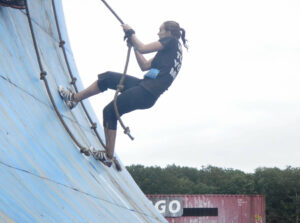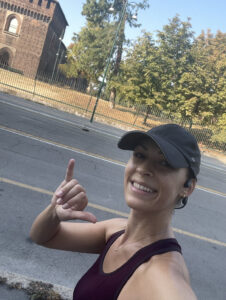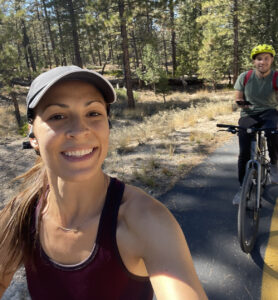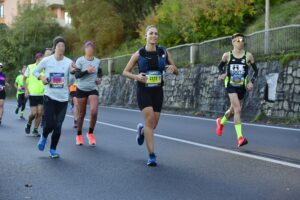The first time I saw “recovery run” on a training plan, I wondered, “What part of running is recovery?”
During my first 5k race with friends, I pushed too hard when I spotted the finish line. I didn’t realize how far I still had to go, so I had to slow down and walk. Growing up, I wasn’t a “runner” or an “athlete.” I was a kid who came home from school, snacked, and watched TV. In my 20s, I discovered fitness and started doing “fun runs” and obstacle course races with friends.

After finishing 26.2 miles, I feel I’ve achieved something once thought impossible. With determination and preparation, running your first marathon becomes achievable and can transform your life. Here’s what I wish I had known before running a marathon and what my training experience was like for my first marathon.
Goal 1: Run 2-3 times every week for 30 minutes
First, I committed to a schedule of running. I signed up for a 10k with a friend because I knew I could run 10 km without training but I wanted to see what would happen if I did train.
I had heard about Jeff Galloway run-walk method used to help runners of all levels complete races and decided to try that. Although I could run for 30 mins without stopping, I had to run very slowly and it felt difficult.
How I did it:
To break it up, I started by running for two minutes, then walking for one minute during a 30-minute treadmill session. Gradually, I increased the running intervals: three minutes running plus one minute walking, then four minutes running plus one minute walking, and finally five minutes running plus one minute walking. I also experimented with increasing my speed on the treadmill during the running intervals.
Although I focused mainly on the run-walk method, I ran a full 30 minutes at my own pace once a week.
How it went:
My leg muscles were tight, and it felt like my body was fighting me. To counter this, I stretched my hamstrings and calves after every run. When discomfort continued, I used a foam roller, which “hurt so good,” especially around my IT band. This helped reduce tightness over time.
After running my 10k, I felt great but what made me most proud was sticking to my running routine.
Goal 2: Increase the length of my long run
Now that I felt confident in my running routine, a major hurdle was behind me. Next I wanted to test how far I could run. There was a park with a 6-mile loop that I used to frequent. I had run this loop occasionally while training for the 10K, but never more than once a week because I needed a few days to recover. It took me just over an hour to complete, so I decided to start doing one “long run” a week, beginning at about an hour.
How I did it:
I ran three times a week: two 30-minute runs and one long run. By this time, I could run 30 minutes continuously several times a week. Each week, I increased my long run by 5-10 minutes. I focused on time-based goals rather than distance. This was because I moved to Italy at this time and I struggled with conversions. European treadmills are obviously set to kilometers and kilometers per hour instead of miles.
How it went:
After running regularly for less than a year, my leg tightness had eased. Once I was comfortable with 80-minute runs, I switched to outdoor long runs. Treadmill long runs had become too miserable for me. During one of these outdoor long runs, I realized I had completed a half marathon.
Years earlier, in my mid-20s, I had run a half marathon and thought, “That was the hardest thing I’ve ever done; I’ll never do that again!” This time, however, I felt great after my unofficial half marathon. I was a bit emotional realizing I had completed this run faster than my previous half marathon.


Goal 3: Follow a marathon training plan and sign up for a marathon
At this point, I began telling people I was training for a marathon. Although it had always been my goal, I was too scared to admit it until now. I explored various free marathon training programs online and decided on the Hal Higdon Beginner Marathon training plan. A friend who recently ran a marathon had used this plan, so I chose it based on her recommendation.
How I did it:
I mostly followed the plan. Initially, I ran three times a week but never on consecutive days. Hal Higdon’s plan required four runs each week, sometimes on back-to-back days. This was challenging because my body was accustomed to rest days after each run. In the first six weeks, I didn’t always run four times a week as prescribed, but I did occasionally run on consecutive days.
In the final months, I managed to run four times a week at the recommended distances.
I also made a few adjustments to Hal Higdon’s plan. I added extra “repeat weeks” due to a family RV trip across the US. Additionally, I included several long runs of around 20 miles to build confidence in handling such a distance by practicing it multiple times.
How it went:
For the first time, I experienced Achilles pain, which worried me because I had treated persistent Achilles tendonitis in a patient when I worked as a PTA. To address this, I avoided hill runs and began doing calf strengthening exercises a few times a week, after the acute pain had lessened.
My marathon training took place mainly during the hot summer months, so I had to wake up very early for my runs and wore a hydration vest on all my long runs. I also tried various sports drinks because I often felt extremely thirsty.
My running paces were much slower than usual. The heat and humidity made it hard to run fast. I accepted that my main goal was consistent weekly mileage, without focusing on speed or hills during my first marathon training cycle.
I completed my longest run before the marathon at Bryce Canyon National Park in Utah while my family was on an RV trip across the US. I ran 21 miles at elevations ranging from about 8,000 to over 9,000 feet. The terrain was extremely hilly. During this run, I experienced nagging pain in my proximal hamstring attachment, near where the hamstring meets the glutes. I had to slow down significantly to manage the pain and avoid injury. However, I felt it was crucial to complete this final long run to build my confidence. My average pace was 13:36 per mile, which was slow for me, but I finished it. The best part was seeing my Akita, Eli, in the back of the car when my family picked me up. He cried and whimpered with excitement when he saw me.

Goal 4: Run a Marathon
Running a marathon is a major mental challenge. By the end of my training cycle, I didn’t feel fully prepared. Every time I attempted a 15+ mile long run in the later training weeks, I doubted my ability to handle those distances. I constantly questioned myself. Yet, each time I completed one of these long runs, I surprised myself.
How I did it:
I kept putting one foot in front of the other for 4 hours and 46 minutes. I completed my first marathon at Lago Maggiore in Italy. Out of 224 finishers, 28 were women. I got through the race by listening to podcasts and music, wearing a hydration vest filled with Gatorade, and carrying running-energy gummies in my pocket.
The night before, I fueled up with a margherita pizza. On race morning, I ate plain Kodiak pancakes. These pancakes had been my go-to before most of my long runs during training. I even brought several boxes of Kodiak pancake mix from the US when I moved to Italy.
A few weeks before the marathon, I heard a podcast about using a race mantra. I created my own: “How bad do you want it?” Initially, I thought a mantra was a bit cheesy, but it turned out to be empowering. I wanted to prove to myself that I am strong, resilient, and capable of achieving my goals. That’s what my mantra represented for me.

How it went:
They ran out of water! I couldn’t believe an organized race could run out of water for a marathon. Although there were plenty of fuel and water stations along the route, by the end, I was tired of Gatorade and craving water. Disappointingly, at the finish line, they had no water left and offered me Coca-Cola instead. I declined.
Another issue was my pre-race nerves. I was anxious all night, worried about the 5-hour 30-minute cutoff. As a first-time marathoner, I feared something might go wrong and I’d be disqualified. I managed to get a few hours of sleep and woke up before my alarm the next morning.
Race day brought perfect weather—partly sunny and 60°F. Initially, the race had strong support with 5k, 10k, half marathon, 33k, and full marathon distances. However, after the half marathon, most runners dropped out, leaving just 224 of us. This meant I often found myself alone on the course and occasionally confused about the route. Running through a town section, I felt a bit lost but thankfully didn’t stray off course.
Meanwhile, my husband enjoyed a full pasta meal with wine while I ran. I appreciated him taking a boat shuttle to cheer me at the 5k, half marathon, and finish line.
During the race, I felt good with no pain, and my half marathon time was better than expected. However, around mile 24, I developed a stitch and had to slow my pace from 12:17 to 16:08 for the last few miles.
My husband gave me a nice compliment. He said, “I see many people crossing the finish line in real pain or barely able to walk, but you seem fine.” He was right. I was exhausted and within an hour ravenously hungry but I was fine.
Current Goal: Get Faster
Two months after the race, I moved to Tokyo with my husband. I had the chance to watch elite runners near the finish line of the Tokyo Marathon. It was incredibly inspiring!
Running a marathon once seemed impossible to me, but I trusted my training, stayed mostly consistent, and succeeded. Now, after a couple of months with only lazy runs of no more than 10 miles, I’m ready to sign up for another race. I plan to include weekly speed workouts and more strength training. I’ve also started incorporating “recovery runs” into my routine.
Completing the marathon led to another unexpected outcome—I started this blog. It’s intimidating to put yourself out there, but if I can run a marathon I want to see what else I can do.
For more novice runner tips or to see our new life in Japan, check out my other posts:
